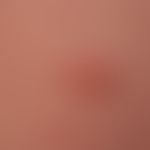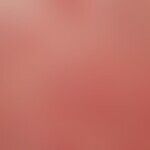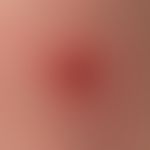Synonym(s)
HistoryThis section has been translated automatically.
Bateman, 1817; Henderson, 1841; Juliusberg, 1905.
Bateman first used the term Molluscum contagiosum in 1817.
Henderson first described "globoid corpuscles" in the lesions in 1841
Juliusberg succeeded in 1905 in transmitting the infection from person to person.
DefinitionThis section has been translated automatically.
A chronic, localized, only rarely generalized (immunodeficiency), self-limited infectious disease of the skin that is widespread throughout the world and is harmless under normal immune conditions. It is caused by the Molluscum contagiosum virus from the Poxviridae group (see poxviruses below). Infection with the virus is not cyclic. Viremia does not occur.
You might also be interested in
PathogenThis section has been translated automatically.
Molluscum contagiosum viruses (MCV; molluscipoxvirus) of subtypes I-IV. These are cuboidal DNA viruses from the Poxviridae group (size: 360 x 219 nm). MCV I is found in about 95% of cases, MCV II in 3-5% of cases. MCV III or IV is very rarely detected intralesionally.
Occurrence/EpidemiologyThis section has been translated automatically.
Molluscum contagiosum is one of the 50 most common diseases worldwide.
There is no sex predisposition.
Molluscum contagiosum is common worldwide with increasing incidence (0.1-1.2% of the population depending on the region) and endemics.
Frequent in tropical areas.
EtiopathogenesisThis section has been translated automatically.
ManifestationThis section has been translated automatically.
Especially in young children and adolescents. In a larger study (n=277), children and adolescents between 1-14 years (average 6.7 years) were affected.
Incubation period: is 2-7 weeks.
Patients with atopic eczema tend to have an increased incidence (disseminated incidence is possible here = Eccema molluscatum). Approximately 25% of those affected also suffer from atopic eczema(of varying intensity).
Infection often occurs after swimming pool visits, e.g. after bathing infants in warm paddling pools.
Also in immunosuppressed adult patients (e.g. AIDS patients; lymphoma patients).
LocalizationThis section has been translated automatically.
Especially on the upper body, upper arm, axillary fold. The combination of arms and trunk is the most common. More rarely: face, eyelids, neck, perianal and perigenital region.
ClinicThis section has been translated automatically.
Predominantly occurring in multiple cases (about 75% of those affected have > 20 Dell's warts).
Mostly scattered or grouped, regionally limited, more rarely also generalized, occasionally arranged in lines (Koebner phenomenon), firm, 0.1-0.4 cm large, usually broadly seated, less frequently pedunculated (see Molluscum contagiosum pediculatum), centrally dented, waxy, whitish, yellowish or pale pink nodules. A whitish, greasy mass can be expressed after scoring the surface.
In rare cases molluscs reach a size of up to 1.5 cm (see below Molluscum contagiosum giganteum).
In immunocompromised patients (see below organ transplants, skin changes) and children with atopic eczema (see Eccema molluscatum), mollusca contagiosa can eruptively generalize > 100 molluscs (comparable to Eccema herpeticatum) or merge into large (up to 10 cm in diameter) plaques.
Verrucae planae-like type: Rarely a small papular "Verrucae planae-like type" is seen in small children with a miliary or also herd-shaped grouped, completely asympomatic sowing of smallest, skin-coloured papules on the trunk and face. This form has a high tendency to spontaneous regression.
LaboratoryThis section has been translated automatically.
HistologyThis section has been translated automatically.
Epithelial acanthoma consisting of several lobules that extend deep into the dermis. The centre is cratered. Here cellular detritus and so-called molluscum corpuscles ("Henderson-Paterson Bodies"): nuclear, homogeneous, dark red-violet stained, epithelial cell-like, ovoid formations = virus-infested epidermis cells. In early lesions with moderate acanthosis, small eosinophilic, intracytoplasmic inclusion bodies are found in the distended suprabasal keratinocytes. In the dermis accompanying lympho-histiocytic infiltrate.
Differential diagnosisThis section has been translated automatically.
Clinical:
- Xanthoma: yellowish, firm, no umbilication of the surface; usually older age.
- Xanthelasma: typical localization is the eyelid area. No central umbilication
- Milia: small, firm white horny beads, not exophytic
- Verrucae vulgares: verrucous, not shiny surface
- Syringoma: usually in the lid area, only flatly protuberant. Higher age
Histological:
- Verruca vulgaris: viral acanthoma also with inclusion bodies. However, these do not show the typical features of molluscum corpuscles (dark red purple colored homogeneous inclusion corpuscles with peripheral nucleus).
Complication(s)(associated diseasesThis section has been translated automatically.
Bacterial superinfection due to contamination with pyogenic germs.
Itching with scratching effects and (auto)inoculation of further molluscum contagiosum viruses, see also Eccema molluscatum.
TherapyThis section has been translated automatically.
The treatment of choice for isolated mollusca contagiosa is curettage in LA. Alternatively, a "wait-and-see" approach may be justified in incompetent children.
- Curettage: Tighten the surrounding skin with two fingers, apply a small non-cutting curette to the base of the molluscum by levering and spoon out against the skin resistance. If necessary, raised wound edges can be smoothed with a cutting curette (e.g. boot no. 3 or 4). Preoperative: It is advisable to mark each molluscum the day before the operation (preferably done by the parents).
- Cryotherapy
- Chemical destruction: 10% KOH solution applied daily to the molluscum, covering the surrounding area with a zinc paste, until an inflammatory reaction occurs. A study comparison with Imiquimod showed an equivalent result for both therapy modalities (healing rate of 40% after 12 weeks of therapy).
- Alternative:
- Incision with a cannula and expression of the individual foci (too cumbersome with a large number of molluscs).
- In the case of localized infestation, a trial with a vitamin A acid cream (e.g. Isotrex) can be carried out; application twice daily.
- Successes have been reported with laser therapy(Erbium-YAG laser, CO 2 laser, dye laser).
- Non-approved empirical therapies:
- Good results (up to 69% response rate) have been described in smaller studies using local treatment with 5% imiquimod cream(3 times/week over several weeks or, according to another study, treatment once/day in the evening and washing off in the morning). Cave: No approved indication.
- Cidofovir, which is promoted as a "last chance" (approval for CMV retinitis). Cidofovir can be applied as a 1% cream (Cave: extremely high price!).
- Ingenolmebutate podophyllotoxin-containing applications.
Complications:
- Individual molluscs show inflammatory focal reactions (e.g. due to mechanical irritation). In these cases, local anesthesia is not sufficient.
- It is not uncommon for molluscs to occur in children with atopic eczema. In this constellation, a superimposed pyoderma can often be observed. It is recommended to treat the pyoderma and eczema consistently for a few days, e.g. with 1% hydrocortisone and 2% clioquinol-containing cream R052.
- Postoperative: Wound centers are provided with a dressing containing polyvidon-iodine (e.g. Betaisodona). This is renewed by the patient the following day. The wound sites generally heal without complications or scarring. In the case of extensive infestation or recurrences, follow-up treatment with Imiquimod (Aldara).
General therapyThis section has been translated automatically.
Anaesthesia: In the case of some molluscs, even small children can be treated without general anaesthesia. It is recommended to treat the affected areas preoperatively for 1/2 hour with a 5.0% Lidocaine Prilocaine cream (e.g. EMLA® cream) occlusively. Due to the formation of methhemoglobin in children, the recommended maximum amounts should be observed: 1g in children < 5kgkgkg; <2g in children <10kgkg; <20g in children over 20kgkg. If necessary, a combination of local anaesthesia with systemic midazolam administration (e.g. Dormicum) may be appropriate. In case of extensive infestation, general anesthesia is preferable.
Progression/forecastThis section has been translated automatically.
In follow-up examinations of larger collectives, mollusca contagiosa heals with and without therapy within 1-62 months (average after 13 months).
In about 50% of children, healing can be expected within 12 months.
Mollusca contagiosa can still be detected in about 30% of the children after 18 months, in about 15% after 24 months.
ProphylaxisThis section has been translated automatically.
Note(s)This section has been translated automatically.
A longer duration of the disease or a larger number of mollusca contagiosa are associated with a reduced quality of life of the affected persons.
LiteratureThis section has been translated automatically.
- Bateman T (1817) Delineations of cutaneous diseases: exhibiting the characteristic appearances of the principal genera and species comprised in the classification of the late Dr. Willan; and completing the series of engravings begun by that author. Longman, Hurst, Rees, Orme and Brown (eds.), Paternoster-Row, London
- Bayerl C et al (2003) Experience in treating molluscum contagiosum in children with imiquimod 5% cream. Br J Dermatol 149 (Suppl 66): 25-28
- De Oreo GA et al (1956) An eczematous reaction associated with molluscum contagiosum. Arch Dermatol 74: 344-348
- Buntin M et al (1991) Sexually transmitted diseases: Viruses and ectoparasites. J Am Acad Dermatol 25: 527-534
- Hengge UR, Cusini M (2003) Topical immunomodulators for the treatment of external genital warts, cutaneous warts and molluscum contagiosum. Br J Dermatol 149 (Suppl 66): 15-19
- Hammes S et al (2001) Molluscum contagiosum: treatment with pulsed dye laser. dermatologist 52: 38-42
- Hengge UR et al (2000) Self administered topical 5% imiquimod for the treatment of common warts and molluscum contagiosum. Br J Dermatol 143: 1026-1031
- Juliusberg M (1905) On knowledge of the virus of the Molluscum contagiosum. Dtsch Med Weekly 31: 1598-1599
- Meykadeh N, Hengge UR (2003) Topical immunomodulators in dermatology. Dermatologist 54: 641-661
- Olsen JR et al(2015) Time to resolution and effect on quality of life of molluscum contagiosum in children in the UK: a prospective community cohort study.Lancet Infect Dis 15:190-195
- Pusey WA (1924) Moluscum contagiosum In: The Principles and Practice of Dermatology, 4th ed. Appleton, S. 989-990
- Valentine CL et al (2000) Treatment modalities for molluscum contagiosum. Dermatologic Therapy 13: 285-289
- Wagner G et al (1989) Percutaneous anaesthesia by application of a lidocaine prilocaine cream (EMLA cream 5%) experience in the therapy of multiple mollusca contagiosa in childhood. Act Dermatol 15: 44-46
Incoming links (28)
Acral papular mucinosis; Bateman, thomas; Ccl1; Classification of viruses; Clioquinol 2%-hydrocortisone 1%-cream (o/w); Contagious epithelioma; Contagious mollusc pediculate; Dock8 deficiency; Eccema molluscatum; Epithelioma molluscum; ... Show allOutgoing links (26)
Acanthoma; Atopic dermatitis (overview); Clioquinol; Clioquinol 2%-hydrocortisone 1%-cream (o/w); Co2 laser; Contagious mollusc pediculate; Curettage; Dye laser; Eccema molluscatum; Eczema herpeticum; ... Show allDisclaimer
Please ask your physician for a reliable diagnosis. This website is only meant as a reference.




































